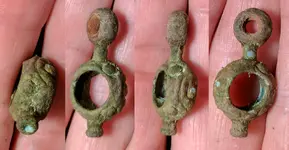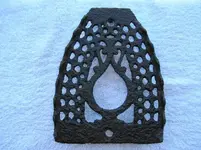OutdoorAdv
Bronze Member
- Joined
- Apr 16, 2013
- Messages
- 2,457
- Reaction score
- 3,351
- Golden Thread
- 1
- Location
- East Coast - USA
- 🥇 Banner finds
- 1
- Detector(s) used
- XP Deus,
GPX 4500,
Equinox 800,
AT Max
- Primary Interest:
- Metal Detecting
Its been a very slow year for me detecting and it had been about 5 weeks since I last went detecting. But, I was able to get out for a bit last week totaling about 16 hours in the field. It was HOT and slow going with lots of bugs! However, I did end up with some really cool items, my favorites being an interesting Fleur-de-lis and crown lead rosette, and a huge infantry overcoat button with a lot of gilt left. I also got a complete iron shoe buckle frame and an interesting (very small) flat iron trivet (stand).
The non-ferrous: (shoe buckle and trivet included)
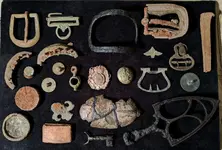
The ferrous:
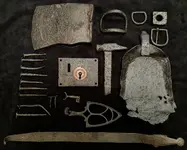
I'm calling this a rosette because it has 3 loops on the back where it looks like it was sewn onto something. I believe its lead based on its patina and weight, but it has some flaking so I suppose it could be a pewter alloy with a higher lead content? It has a Fleur-de-lis with 4 stars (*edit: not stars, but 4 smaller Fleur de lis) and a crown on top. I'm open to input on what it might be or what it might mean.
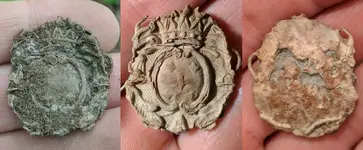
This is my first overcoat button and my nicest CW era button. It has a lot of gilt left and cleaned up nicely. The backmark is "D. EVANS & CO. *ATTLEBORO MASS*"
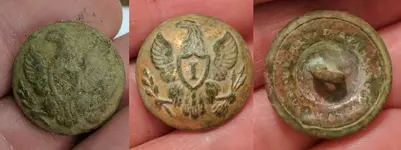
I've dug a few iron frame fragments and iron chapes and tongues... I've preserved complete iron shoe buckles for friends, but I hadnt found a complete iron frame myself. So I was pretty pleased to get this one. It's solid and preserved very nice.
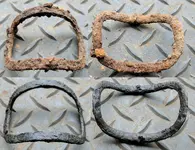
This flat iron trivet was something I didn't even know existed. Its tiny and apparently a stand for a very small flat iron. It crossed my mind when I pulled it from the dirt, that it looked like a flat iron associated item, but I figured it was way too small. Thanks to my friend Ahab8 for the proper ID of it and to my friend Bill D. for the proper (trivet) terminology. Love digging things I didn't know existed and learning about them.
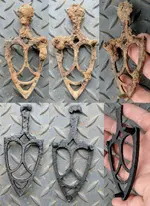
Would love some more info on this all iron hammer with a chisel end. There is a similar one on the Crouch book, in the artillery section, however I believe this one was just used around the house. Maybe a mason hammer, farrier hammer or blacksmith hammer... or just a tack hammer! Anyway I thought it was really cool and preserved nicely.
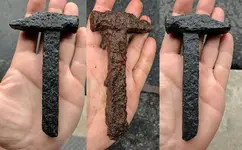
You guys can laugh at me for this, but I did glue this horrendous rattail spoon back together... had it not had a sweet rattail on it, I would have chucked these pewter bits into the junk pile. It came out of the dirt in 3 pieces. I wanted to practice putting it back together for my next-awesome-yet-to-be-dug pewter item that needs assembly So I coated them in Elmers, tacked them with super glue, and filled in the cracks with epoxy. Happy with that technique.
So I coated them in Elmers, tacked them with super glue, and filled in the cracks with epoxy. Happy with that technique.
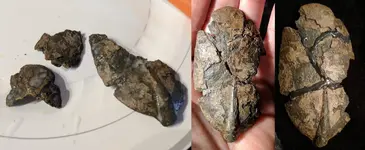
Hand forged felling axe, with a stamp of "Cannon" on the head. My friend Z.K. sent me the book "American Axes" that has a list of makers. Unfortunately I don't see a maker listed for "Cannon". Complete axe heads are some of my favorite iron relics to preserve.
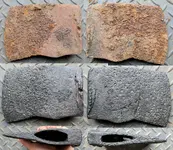
Cool mortise lock with a copper or brass lock plate. I like preserving mixed material items, but I've yet to find a material to keep the copper or brass from being exposed to electrolysis, so I can retain its patina. I tried Vaseline on this one, but the heat in the electrolyte melted it away in an hour! I've tried wax and tape in the past... I'll think of something else to try next time.
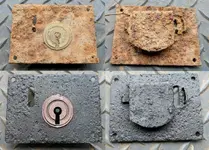
Hand forged fireplace shovel I wish it was complete... but this is a household item I would consider more personal, since it had a use in daily life. The bracket is hand forged and riveted. Neat piece and preserved nicely.
I wish it was complete... but this is a household item I would consider more personal, since it had a use in daily life. The bracket is hand forged and riveted. Neat piece and preserved nicely.
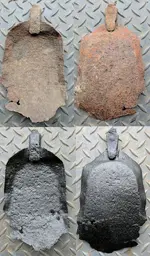
In the non-ferrous group shot there is a small, round tin. When I shook it, I sounded like fluid was inside. I had been wondering what was in there for the last 5 days, but I wanted to finish electrolysis and take my pictures for this post, before I destroyed it! So after photos yesterday, I carefully opened it... no gold coins and diamonds in there... just nasty water. BUT there was a surprise, because the tin was lettered. It says "Silver Gem -One Cent- Chewing Gum" and I added a non-dug online example.
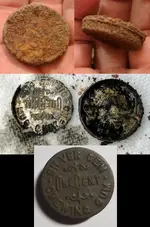
Close up's of the non-ferrous
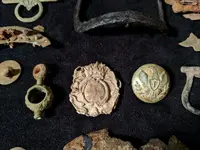
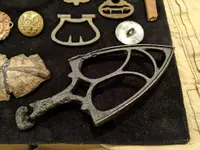
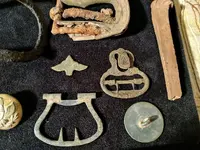
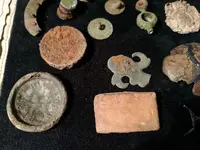
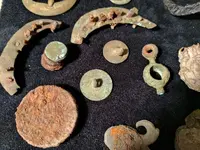
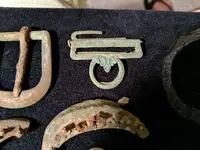
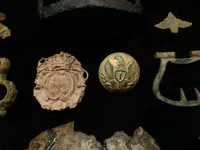
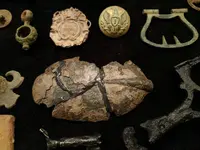
... And the trash and iron. There is a 3 foot, 6 inch strap hinge at the top with a clinched rose head and hand forged nuts and bolts.
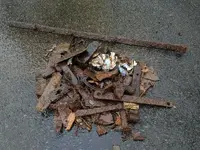
Thank for looking and happy hunting everyone.
The non-ferrous: (shoe buckle and trivet included)

The ferrous:

I'm calling this a rosette because it has 3 loops on the back where it looks like it was sewn onto something. I believe its lead based on its patina and weight, but it has some flaking so I suppose it could be a pewter alloy with a higher lead content? It has a Fleur-de-lis with 4 stars (*edit: not stars, but 4 smaller Fleur de lis) and a crown on top. I'm open to input on what it might be or what it might mean.

This is my first overcoat button and my nicest CW era button. It has a lot of gilt left and cleaned up nicely. The backmark is "D. EVANS & CO. *ATTLEBORO MASS*"

I've dug a few iron frame fragments and iron chapes and tongues... I've preserved complete iron shoe buckles for friends, but I hadnt found a complete iron frame myself. So I was pretty pleased to get this one. It's solid and preserved very nice.

This flat iron trivet was something I didn't even know existed. Its tiny and apparently a stand for a very small flat iron. It crossed my mind when I pulled it from the dirt, that it looked like a flat iron associated item, but I figured it was way too small. Thanks to my friend Ahab8 for the proper ID of it and to my friend Bill D. for the proper (trivet) terminology. Love digging things I didn't know existed and learning about them.

Would love some more info on this all iron hammer with a chisel end. There is a similar one on the Crouch book, in the artillery section, however I believe this one was just used around the house. Maybe a mason hammer, farrier hammer or blacksmith hammer... or just a tack hammer! Anyway I thought it was really cool and preserved nicely.

You guys can laugh at me for this, but I did glue this horrendous rattail spoon back together... had it not had a sweet rattail on it, I would have chucked these pewter bits into the junk pile. It came out of the dirt in 3 pieces. I wanted to practice putting it back together for my next-awesome-yet-to-be-dug pewter item that needs assembly
 So I coated them in Elmers, tacked them with super glue, and filled in the cracks with epoxy. Happy with that technique.
So I coated them in Elmers, tacked them with super glue, and filled in the cracks with epoxy. Happy with that technique.
Hand forged felling axe, with a stamp of "Cannon" on the head. My friend Z.K. sent me the book "American Axes" that has a list of makers. Unfortunately I don't see a maker listed for "Cannon". Complete axe heads are some of my favorite iron relics to preserve.

Cool mortise lock with a copper or brass lock plate. I like preserving mixed material items, but I've yet to find a material to keep the copper or brass from being exposed to electrolysis, so I can retain its patina. I tried Vaseline on this one, but the heat in the electrolyte melted it away in an hour! I've tried wax and tape in the past... I'll think of something else to try next time.

Hand forged fireplace shovel
 I wish it was complete... but this is a household item I would consider more personal, since it had a use in daily life. The bracket is hand forged and riveted. Neat piece and preserved nicely.
I wish it was complete... but this is a household item I would consider more personal, since it had a use in daily life. The bracket is hand forged and riveted. Neat piece and preserved nicely.
In the non-ferrous group shot there is a small, round tin. When I shook it, I sounded like fluid was inside. I had been wondering what was in there for the last 5 days, but I wanted to finish electrolysis and take my pictures for this post, before I destroyed it! So after photos yesterday, I carefully opened it... no gold coins and diamonds in there... just nasty water. BUT there was a surprise, because the tin was lettered. It says "Silver Gem -One Cent- Chewing Gum" and I added a non-dug online example.

Close up's of the non-ferrous








... And the trash and iron. There is a 3 foot, 6 inch strap hinge at the top with a clinched rose head and hand forged nuts and bolts.

Thank for looking and happy hunting everyone.

Last edited:
Upvote
37




